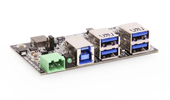RS232, RS422, and RS485 are three simple serial protocols widely used for decades across industrial, commercial, and military applications. They all share the same basics logical protocols, making them relatively easy to link via converters and render compatible. They primarily vary from one another in their physical implementation.
For example, voltage and signaling are what must be accounted for when using an RS232 to RS422 converter. These two protocols are almost always used in very similar applications, so it’s very common for the need to arise to create a signal conversion between the two. A common scenario would be to create a conversion to interface an RS422 or RS485 device with a common port on a PC, RS232.
RS232 to RS422 and RS485 conversion is generally achieved using some of the many commercially available adapters that use RS232 and RS485 transceiver IC’s to provide the required voltage signaling translations. The only significant drawback to these adapters, when their application is well planned and thoroughly considered, is that they require an external power supply, usually 5V a wall transformer, to provide power to the transceiver IC’s.
RS232: Still Common, Still Useful
Extending the physical distances over which devices with RS232 interfaces can operate is a common need, along with creating a conversion between different signaling protocols. This perhaps comes up most often with legacy printers and in automated manufacturing settings.
Relatively inexpensive, and simple solutions are available via high-quality RS232 to RS422 converter units. The RS232 specification supports synchronous and asynchronous data transmission between modems, printers, personal computers, and other data communication devices via either a 25 pin connection or a 9 pin connection. Data transmission speed for RS232 is possible up to 20 kbps under 50 feet.
RS422 Can Extend the Utility of RS232
RS422 was an upgraded version of RS232 when it was introduced. It enables higher data rates to be transferred over serial data lines. Using reduced data rates (100 KBS), it can also transmit much farther, up to 4000 feet, which, needless to say, can be extremely useful. The upgraded protocol also used differential transmitters and receivers, allowing it to be more resilient to mode interference, an advantage in noisy industrial settings.
Most importantly though, despite its many differences, RS422 can often be used as a direct interface with RS232 in many circumstances.
Therefore, with an RS422 to RS232 converter, you can extend the transmission distance up to 4,000 feet. Power can be provided to a portable RS232 to RS422 converter via the converter port, though some models allow external power to be connected when necessary. Portable converters tend to support full-duplex, bi-directional, speeds between 300 bps and 115 kbps.
USB to RS422 is Convenient With Newer Technologies
USB to RS422 converters are also a convenient option, often able to be used in place of an RS232 to R422 converter, since the RS422 is essentially the heir to RS232, and uses a balanced four-wire system with one pair of wires handling DTE-DCE transmission, and the other DCE-DTE transmission. USB to Serial Adapters can be utilized through an existing USB Port to work with your legacy serial connections. It’s great for newer technologies with no serial port connections.
The Setup
The RS232 end of the converter has a DB-9 connector, generally. The RS422 side generally had a DB-9 male or a multi-way terminal block implemented. The RS232 side’s length will still be limited to the standard RS232 lengths, about 15 meters, but the intermediate RS422 side can range up to 4000 feet mark.
It’s recommended to run a signal ground across the RS422 converter, even though the differential signals the balanced lines can achieve higher data rates in noisy environments. Additionally, a pair of converter units will be required unless the far-end device already supports RS422.
It may be necessary for a host/PC to communicate with devices that are not Lan-aware but capable of communicating with RS422 devices. This is where a Master/Slave multi-drop RS422 converter configuration can be used to control up to 32 devices over a distance of 4,000 feet (1200 meters.)
Coolgear can support any of the applications you might need and can design customers converters in their Coolgear Labs when you need high quality, custom solutions
Don’t hesitate to reach out, get your questions answered, and get the solutions you need.




















